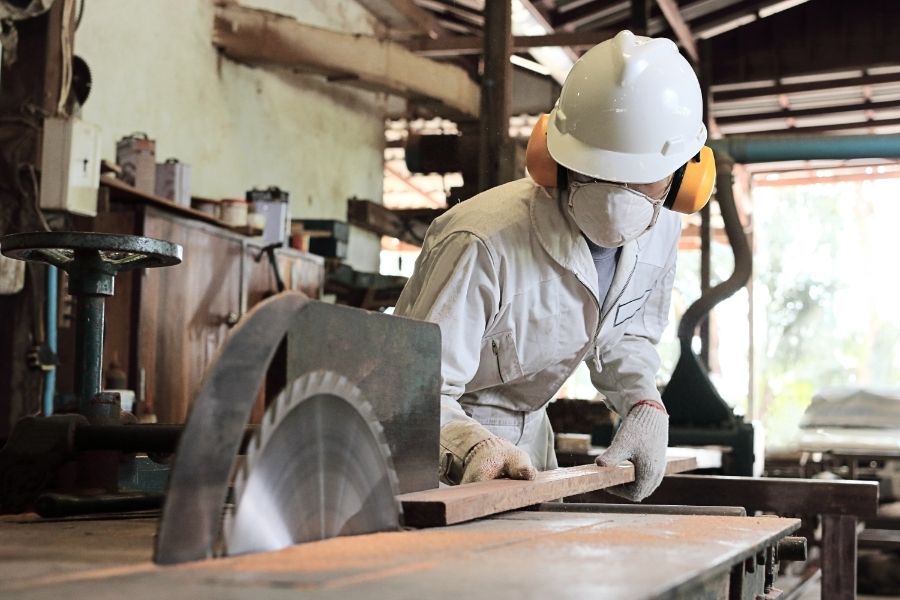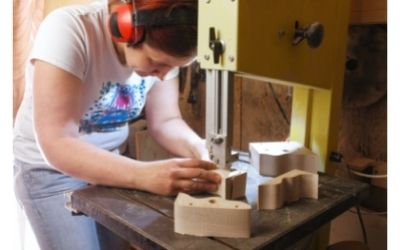 If you’re wondering, what does a band saw do better than a table saw? it may be because you’re deciding between the two power tools. After all, band saws and table saws are two very different, but are still quite important tools in woodworking workshops and garages. If you’re setting up shop for the first time or scaling down to a smaller shop, learning the ropes of scroll saws and band saws is a great place to start.
If you’re wondering, what does a band saw do better than a table saw? it may be because you’re deciding between the two power tools. After all, band saws and table saws are two very different, but are still quite important tools in woodworking workshops and garages. If you’re setting up shop for the first time or scaling down to a smaller shop, learning the ropes of scroll saws and band saws is a great place to start.
Related Posts: What is a Band Saw Used For?
What if you only have room for either a band saw or table saw? Or maybe you just want to enjoy the versatility the band saw presents. Read on to learn what a band saw does better than a table saw.
What Does a Band Saw Do (better than a table saw)
A band saw cuts lumber into intricate and irregular shapes such as curves and perfect circles more easily than a table saw. It’s also extremely effective at ripping or resawing thick lumber into thinner pieces and crosscutting the short pieces. Moreover, a band saw makes perfect veneers and easily cuts other harder materials such as metal when it’s equipped with the right blade.
Related Posts: Top Rated Table Saws
Do I Really Need a Bandsaw?

A band saw might not be the first stationary power tool you equip your startup woodworking shop with, but it’s an exceptionally versatile tool. You really need this saw for artistic and intricate woodwork such as making complex intricate cuts, cutting curves and edges, and making laminations. A band saw will come in handy when performing these tasks:
-
Making relief cuts
When cutting a curve of a very small radius, the blade of a saw can bind. You can prevent this by cutting relief cuts into the lumber, and a band saw is your perfect tool for this. In fact, this is one of the unique cuts that a band saw can make.
A relief cut is made where the curve takes a sharp turn. It involves making a sharp cut into the waste material up to the cut line and then backing out. This frees the band saw blade and allows you to continue with your curve cuts.
-
Cutting intricate curves
Cutting curves through lumber is one of the most unique selling points of a band saw. Even better, the saw can cut perfect, irregular, and elaborate curves through thick and thin pieces of lumber alike. Curve cuts involve marking the curve cut and relief cut lines, and a band saw is perfect for this.
Cutting curves requires you to first make relief cuts. This way, you don’t cut the entire curve in one fluid go. Rather, you cut a perfect curve in bits, stopping at each relief cut. This allows you to cut flawless curves without binding the saw blade.
If you’re planning on cutting perfect circles, a band saw is your best tool. What’s more, the task is easy and straightforward. Better still, a band saw uses a small blade with small teeth and this prevents it from binding when cutting curves and circles.
-
Cutting lumber straight
Although making straight cuts through lumber is the most basic and easiest part of woodworking, it can still be challenging to most beginners. A band saw can help you overcome this challenge as it’s one of the easiest to use. You only need to hold the saw firmly in place using your hands to make a perfect straight line.
If your hands are shaky, you can use a band saw along with the fence to make a perfect straight cut. The fence guides the piece of lumber in a straight line through the saw blade and enables you to make accurate straight cuts.
Related Posts: Best Bandsaw Blades for Resawing
-
Making wood veneer
A band saw is probably your best and easiest tool for making perfect wood veneer. It enables you to saw a piece of lumber into numerous matching pieces that can be used together or separately.
For instance, you can cut wood into sets of curved doors or matching drawer boards easily using this saw. This also helps you to skimp on woodworking material by using idle pieces that would have otherwise gone to waste.
-
Resawing (ripping) lumber
Resawing involves cutting broad pieces of lumber into smaller and thinner sheets. A band resaws lumber more accurately, faster, and more easily than most other types of saws. If you want to slice though large logs of wood without a hassle, use the best band saw blades for resawing. Resawing enables you to save woodworking resources by making more products from a limited supply.
-
Laminating lumber
Lamination involves making a desired shape of lumber using identical pieces of thinner wood glued together. There’s no better saw to cut the individual laminates than a band saw. After cutting, you should bend and hold the pieces in your desired shape before gluing them in place. This is a great way to make fancy and functional woodwork designs and save resources in the process.
-
Cutting metal
The band saw is the master of versatility in cutting materials. Unlike most other types of saws, you can use it to cut harder materials such as metal. The cut may not be perfect as in the case of wood, but it’s still a noteworthy perk. Remember to use a suitable blade when using a band saw to slice through metal.
Related Posts: How Much Does a Scroll Saw Cost?
Should I Buy a Bandsaw or a Table Saw?

You’re probably wondering which one between a band saw and table saw is best for you. These factors can help you narrow down to the best saw choice for you workshop between the two:
-
The saw footprint
A table saw typically sits at the centre of a workshop and everything else is built around it. Since it takes a huge piece of your floor space, it can be disadvantageous where this resource is scarce and premium. On the other hand, a band saw can be installed against a wall and takes only a small fraction of the footprint. Note that a large industrial band saw can take up less floor space than a domestic-use table saw.
You also need to consider the space you need to work around the saw assembly. If floor space and footprint are your primary considerations, a band saw is superior to a table saw.
-
Quality of straight cuts
When set up correctly, a table saw produces incredibly accurate straight cuts. Not only this, but you can also produce perfect square and parallel cuts easily using a table saw when you set the fence properly. Better still, a table saw with a carefully maintained blade yields exceptionally clean straight cuts that may only need light sanding.
A band saw blade wobbles a little and leaves some saw marks even when it’s set at optimum. This makes it hard to make perfect straight and clean cuts using a band saw, making a table saw preferable.
-
Ease of changing saw blades
You want to be able to swap saw blades swiftly, efficiently, and safely if you’re cutting a variety of materials. For instance, you may want to rip solid wood, cut sheet material, and crosscut solid wood using the same saw. A table saw makes this process a breeze- simply undo the arbor nut, remove the blade, replace it with a new blade, and then tighten the nut.
Switching blades in a band saw can be is a hustle and takes up precious time. You need to reset the tracking, tension, bearings, and the fence. So, if you don’t have band saw setups with different blades for different materials, then a table saw is easier and more convenient.
-
Versatility
A table saw is ideal for making perfect straight, long, square cuts with a clean cut finish. Although a band saw can do this too, it’s less accurate. Nevertheless, a band saw is awesome at making awesome scrolling cuts, cutting curves, resawing lumber, making wood veneer, and cutting a variety of materials such as metal, plastic, and meat. If you’re looking for the more versatile tool between the two, the band saw is your winner.
-
Safety of use
Although many variables are at play here, a band saw is generally safer than a table saw. A band saw cuts downward and presses the material onto the table. Contrary to this, a table saw cuts toward its operator and can plunge the lumber onto the operator in case of kickback. This mostly happens when the lumber pinches together or springs apart when it’s being cut.
Either way, you should exercise caution when using either a table or band saw as both can easily slice off your fingers.
-
Depth of cuts
Sometimes, you’ll want to cut partially though lumber instead of through it. For instance, when cutting dados, grooves, and tongues. In such cases, a table saw with a height-adjustable blade is your best bet. You can’t use a band saw for such cuts, but you can use a router.
-
Noise
Generally, a band saw is quieter than a table saw.
-
Beveling
A table saw with a tilting blade is great for making long and straight bevel cuts but you’d have to tilt the work piece instead of the blade to make these cuts with a band saw.
-
Kerf
This is the amount of material dislodged from the working piece by a saw blade as it cuts. A band saw yields less kerf than a table saw as it has a thinner and smaller blade.
In the end, the decision to buy a table saw or band saw depends on the material you’re cutting, the type of cuts you’re making, and your personal preferences.
Related Posts: Best Bandsaws for Resawing
What Can a Bandsaw do that a Table Saw can’t?
A band saw can make scroll (curve) cuts but a table saw can’t. It can also cut through exceptionally thick pieces of lumber and other materials such as plastic and metal but a table saw can’t. In both cases, a table saw’s larger blade and teeth would bind into the working material but the smaller blade and teeth of a band saw slice through the materials easily.
What Speed Should a Bandsaw Run at?
A few models of band saws allow you to tweak the speed of the blade from the common 1000 FPM (feet per minute). For all your woodworking cuts, the ideal speed for a band saw is between 1000 to 5000 FPM (approximately 3000 FPM) regardless of the tooth configuration or width of the blade.
This table shows the best speeds to use a band saw when cutting different materials:
| Type of Material | Approximate recommended band saw speed |
| Wood | 3000 FPM |
| Aluminum | 1000 FPM |
| Steel | 100 FPM |
| Brass | 100 FPM (or a little higher) |
| Plastics | Varying speeds depending on the manufacturer |
Ensure your band saw blade is properly lubricated when cutting hard materials so you can end up with those desirable clean cuts.
Final thoughts
While a band saw is used to make a variety of cuts in woodworking, it’s a versatile workshop tool that cuts through many other materials such as plastics and metals. Its ease and efficiency in making intricate curved cuts, resawing thick lumber into smaller and thinner pieces, and cutting veneers makes it a worthy addition to any workshop.
